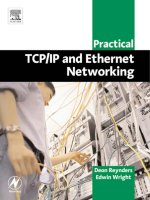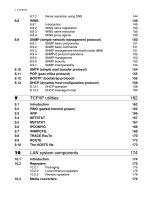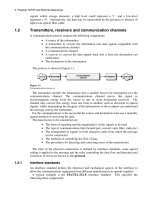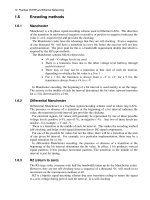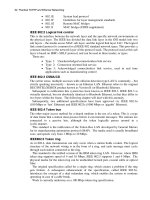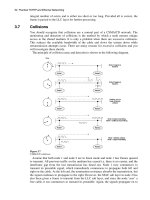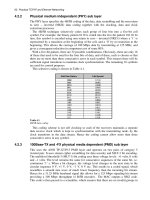Practical TCP/IP and Ethernet Networking- P9 ppsx
Bạn đang xem bản rút gọn của tài liệu. Xem và tải ngay bản đầy đủ của tài liệu tại đây (498.51 KB, 10 trang )
62 Practical TCP/IP and Ethernet Networking
4.2.2 Physical medium independent (PHY) sub layer
The PHY layer specifies the 4B/5B coding of the data, data scrambling and the non return
to zero – inverted (NRZI) data coding together with the clocking, data and clock
extraction processes.
The 4B/5B technique selectively codes each group of four bits into a five-bit cell
symbol. For example, the binary pattern 0110 is coded into the five-bit pattern 01110. In
turn, this symbol is encoded using non return to zero – inverted (NRZ-I) where a ‘1’ is
represented by a transition at the beginning of the cell, and a ‘0’ by no transition at the
beginning. This allows the carriage of 100 Mbps data by transmitting at 125 MHz, and
gives a consequent reduction in component cost of some 80%.
With a five-bit pattern, there are 32 possible combinations. Obviously, there are only 16
of these that need to be used for the four bits of data, and of these, each is chosen so that
there are no more than three consecutive zeros in each symbol. This ensures there will be
sufficient signal transitions to maintain clock synchronization. The remaining 16 symbols
are used for control purposes.
This selective coding is shown in Table 4.1.
Table 4.1
4B/5B data coding
This coding scheme is not self clocking so each of the receivers maintains a separate
data receive clock which is kept in synchronization with the transmitting node, by the
clock transitions in the data stream. Hence the coding cannot allow more than three
consecutive zeros in any symbol.
4.2.3 100Base-TX and -FX physical media dependent (PMD) sub layer
This uses the ANSI TP-X3T9.5 PMD layer and operates on two pairs of category 5
twisted pair. It uses stream cipher scrambling for data security and MLT-3 bit encoding.
The multilevel threshold-3 (MLT-3) bit coding uses three voltage levels: +1 volts, 0 volts
and –1 volts. The level remains the same for consecutive sequences of the same bit, i.e.
continuous ‘1’ s. When a bit changes, the voltage level changes to the next state in the
circular sequence 0 V, +1 V, 0 V, –1 V, 0 V etc. This results in a coded signal, which
resembles a smooth sine wave of much lower frequency than the incoming bit stream.
Hence for a 31.25 MHz baseband signal this allows for a 125 Mbps signaling bit stream
providing a 100 Mbps throughput (4 B/5B encoder). The MAC outputs a NRZ code.
This code is then passed to a scrambler, which ensures that there are no invalid groups in
Fast and gigabit Ethernet systems 63
its NRZI output. The NRZI converted data is passed to the three level code block and the
output is then sent to the transceiver. The code words are selectively chosen so the mean
line signal line zero, in other words the line is DC balanced.
The three level code results in a lower frequency signal. Noise tolerance is not as high
as 10Base-T because of the multilevel coding system; hence data grade (category 5) cable
is required.
Two pair wire, RJ45 connectors and a hub are requirements for 100Base-TX. These
factors and a maximum distance of 100 m between the nodes and hubs make for a very
similar architecture to 10Base-T.
4.2.4 100Base-T4 physical media dependent (PMD) sub layer
The 100Base-T4 systems use four pairs of Category 3 UTP. It uses data encoded in an
eight binary six ternary (8B/6T) coding scheme similar to the MLT-3 code. The data is
encoded using three voltage levels per bit time of +V, 0 volts and –V, these are usually
written as simply +, 0 and –. This coding scheme allows the eight bits of binary data to be
coded into six ternary symbols, and reduces the required bandwidth to 25 MHz. The 256
code words are chosen so the line has a mean line signal of zero. This helps the receiver
to discriminate the positive and negative signals relative to the average zero level. The
coding utilizes only those code words, which have a combined weight of 0 or +1, as well
as at least two signal transitions for maintaining clock synchronization. For example, the
code word for the data byte 20H is –++–00, which has a combined weight of 0 while
40H is –00+0+, which has a combined weight of +1.
If a continuous string of code words of weight +1 is sent then the mean signal will
move away from zero, known as DC wander. This causes the receiver to misinterpret the
data since it is assuming the average voltage it is seeing, which is now tending to ‘+1’, is
its zero reference. To avoid this situation, a string of code words of weight +1 is always
sent by inverting alternate code words before transmission. Consider a string of
consecutive data bytes 40H, the codeword is –00+0+ which has weight +1. This is sent
as the sequence –00+0+, +00–0–, –00+0+, +00–0– etc, which results in a mean signal
level of zero. The receiver consequently reinverts every alternate codeword prior to
decoding.
These signals are transmitted in half-duplex over three parallel pairs of category 3, 4 or
5 UTP cable, while a fourth pair is used for reception of collision detection signals. This
is shown in Figure 4.3.
Figure 4.3
100Base-T4 wiring
64 Practical TCP/IP and Ethernet Networking
100Base-TX and 100Base-T4 are designed to be interoperable at the transceivers using
a media independent interface and compatible (class 1) repeaters at the hub. Maximum
node to hub distances of 100 m and 250 m maximum network diameter are supported.
Maximum hub-to-hub distance of 10 m.
4.2.5 100Base-T2
The 100Base-T2 system was published by the IEEE in 1996 as the IEEE 802.3y standard
but has not been marketed at this stage. It was designed to address the shortcomings of
100Base-T4, making full-duplex 100 Mbps accessible to installations with only two
category 3 cable pairs available. The standard was completed two years after 100Base-
TX, at which stage the -TX had such market dominance that the -T2 products were not
commercially produced. However it is mentioned here for reference and because its
underlying technology using digital signal processing (DSP) techniques and five-level
coding (PAM-5) is used for the 1000Base-T systems on two category 5 pairs. These are
discussed in detail under 1000Base-T systems in Section 4.5.
The features of 100Base-T2 are:
• Uses two pairs of category 3, 4 or 5 UTP
• Uses both pairs for simultaneously transmitting and receiving – commonly
known as dual-duplex transmission. This is achieved by using digital signal
processing (DSP) techniques
• Uses a five-level coding scheme with five phase angles called pulse
amplitude modulation (PAM 5) to transmit two bits per symbol
4.2.6 100Base-T hubs
The IEEE 802.3u specification defines two classes of 100Base-T hubs, which are
normally called repeaters:
• Class I, or translational repeaters which can support both TX/FX and T4
systems
• Class II, or transparent repeaters which support only one signaling system
The class I repeaters have greater delays (0.7 µs maximum) in supporting both
signaling standards and so only permit one hub in each collision domain. The class I
repeater fully decodes each incoming TX or T4 packet into its digital form at the media
independent interface (MII) and then sends the packet out as an analog signal from each
of the other ports in the hub. Repeaters are available with all T4 ports, all TX ports or
combinations of TX and T4 ports, called translational repeaters. Their layout is shown in
Figure 4.4.
The class II repeaters operate like a 10Base-T repeater connecting the ports (all of the
same type) at the analog level. These then have lower inter-repeater delays (0.46 µs
maximum) and so two repeaters are permitted in the same collision domain, but only 5 m
apart. Alternatively, in an all fiber network, the total length of all the fiber segments is
228 meters. This allows two 100 m segments to the nodes with 28 m between the
repeaters or any other combination. Most fast Ethernet repeaters available today are class
II.
Fast and gigabit Ethernet systems 65
Figure 4.4
Class I and class II fast Ethernet repeaters
4.2.7 100Base-T adapters
Adapter cards are readily available as standard 100Mbps and as 10/100Mbps. These latter
cards are interoperable at the hub on both speed systems.
4.3 Fast Ethernet design considerations
4.3.1 UTP cabling distances 100Base-TX/T4
Maximum distance between UTP hub and desktop NIC is 100 meters, made up
as follows:
• 5 meters from hub to patch panel
• 90 meters horizontal cabling from patch panel to office punch-down block
• 5 meters from punch-down block to desktop NIC
4.3.2 Fiber optic cable distances 100Base-FX
The following maximum cable distances are in accordance with the 100Base-T bit budget
(see Section 4.4.3).
Node to hub: maximum distance of multimode cable (62.5/125) is 160 meters (for
connections using a single Class II repeater).
Node to switch: maximum multimode cable distance is 210 meters.
Switch-to-switch: maximum distance of multimode cable for a backbone connection
between two 100Base-FX switch ports is 412 meters.
Switch-to-switch, full-duplex: maximum distance of multimode cable for a full-duplex
connection between two 100Base-FX switch ports is 2000 meters.
Note The IEEE have not included the use of single mode fiber in the 802.3u standard.
However numerous vendors have products available enabling switch-to-switch distances
of up to ten to twenty kilometers using single mode fiber.
4.3.3 100Base-T repeater rules
The cable distance and the number of repeaters, which can be used in a 100Base-T
collision domain, depends on the delay in the cable and the time delay in the repeaters
and NIC delays. The maximum round-trip delay for 100Base-T systems is the time to
66 Practical TCP/IP and Ethernet Networking
transmit 64 bytes or 512 bits and equals 5.12 µs. A frame has to go from the transmitter to
the most remote node then back to the transmitter for collision detection within this round
trip time. Therefore the one-way time delay will be half this.
The maximum sized collision domain can then be determined by the following
calculation:
Repeater delays + Cable delays + NIC delays + Safety factor (5 bits
minimum)< 2.56 µs
The following Table 4.2 gives typical maximum one-way delays for various
components. Repeater and NIC delays for specific components can be obtained from the
manufacturer.
Table 4.2
Maximum one-way fast Ethernet component delays
Notes
If the desired distance is too great it is possible to create a new collision domain by using
a switch instead of a repeater.
Most 100Base-T repeaters are stackable, which means multiple units can be placed on
top of one another and connected together by means of a fast backplane bus. Such
connections do not count as a repeater hop and make the ensemble function as a
single repeater.
4.3.4 Sample calculation
Can two fast Ethernet nodes be connected together using two class II repeaters connected
by 50 m fiber? One node is connected to the first repeater with 50 m UTP while the other
has a 100 m fiber connection.
Calculation: Using the time delays in Table 4.3
Table 4.3
Time delays
Fast and gigabit Ethernet systems 67
The total one-way delay of 2.445 µs is within the required interval (2.56 µs) and allows
at least 5 bits safety factor, so this connection is permissible.
4.4 Gigabit Ethernet 1000Base-T
4.4.1 Gigabit Ethernet summary
Gigabit Ethernet uses the same 802.3 frame format as 10 Mbps and 100 Mbps Ethernet
systems. This operates at ten times the clock speed of Fast Ethernet at 1Gbps. By
retaining the same frame format as the earlier versions of Ethernet, backward
compatibility is assured with earlier versions, increasing its attractiveness by offering a
high bandwidth connectivity system to the Ethernet family of devices.
Gigabit Ethernet is defined by the IEEE 802.3z standard. This defines the gigabit
Ethernet media access control (MAC) layer functionality as well as three different
physical layers: 1000Base-LX and 1000Base-SX using fiber and 1000Base-CX using
copper. These physical layers were originally developed by IBM for the ANSI Fiber
channel systems and used 8B/10B encoding to reduce the bandwidth required to send
high-speed signals. The IEEE merged the fiber channel to the Ethernet MAC using a
gigabit media independent interface (GMII), which defines an electrical interface,
enabling existing fiber channel PHY chips to be used and enabling future physical layers
to be easily added.
1000Base-T is being developed to provide service over four pairs of category 5 or
better copper cable. As discussed earlier this uses the same technology as 100Base-T2.
This development is defined by the IEEE 802.3ab standard.
These gigabit Ethernet versions are summarized in Figure 4.5.
Figure 4.5
Gigabit Ethernet versions
4.4.2 Gigabit Ethernet MAC layer
Gigabit Ethernet retains the standard 802.3 frame format, however the CSMA/CD
algorithm has had to undergo a small change to enable it to function effectively at 1 Gbps.
The slot time of 64 bytes used with both 10 Mbps and 100 Mbps systems has been
increased to 512 bytes. Without this increased slot time the network would have been
impractically small at one tenth of the size of fast Ethernet – only 20 meters!
68 Practical TCP/IP and Ethernet Networking
The slot time defines the time during which the transmitting node retains control of the
medium, and in particular is responsible for collision detection. With gigabit Ethernet it
was necessary to increase this time by a factor of eight to 4.096 µs to compensate for the
tenfold speed increase. This then gives a collision domain of about 200 m.
If the transmitted frame is less than 512 bytes the transmitter continues transmitting to
fill the 512-byte window. A carrier extension symbol is used to mark frames, which are
shorter than 512 bytes, and to fill the remainder of the frame. This is shown in
Figure 4.6.
Figure 4.6
Carrier extension
While this is a simple technique to overcome the network size problem, it could cause
problems with very low utilization if we send a lot of short frames, typical of some
industrial control systems. For example, a 64-byte frame would have 448 carrier
extension symbols attached and result in a utilization of less than 10%. This is
unavoidable, but its effect can be minimized if we are sending a lot of small frames by a
technique called packet bursting. Once the first frame in a burst has successfully passed
through the 512-byte collision window, using carrier extension if necessary, transmission
continues with additional frames being added to the burst until the burst limit of 1500
bytes is reached. This process averages the time wasted sending carrier extension symbols
over a number of frames. The size of the burst varies depending on how many frames are
being sent and their size. Frames are added to the burst in real-time with carrier extension
symbols filling the inter packet gap. The total number of bytes sent in the burst is totaled
after each frame and transmission continues until at least 1500 bytes have been
transmitted. This is shown in Figure 4.7.
Figure 4.7
Packet bursting
Fast and gigabit Ethernet systems 69
4.4.3 Physical medium independent (PHY) sub layer
The 802.3z Gigabit Ethernet standard used the three PHY sub layers from the ANSI
X3T11 fiber channel standard for the 1000Base-SX and 1000Base-LX versions using
fiber optic cable and 1000Base-CX using shielded 150-ohm twinax copper cable.
The Fiber Channel PMD sub-layer ran at 1 Gbaud and specifies the 8B/10B coding of
the data, data scrambling and the non return to zero – inverted (NRZI) data coding
together with the clocking, data and clock extraction processes. This translated to a data
rate of 800 Mbps. The IEEE then had to increase the speed of the fiber channel PHY
layer to 1250 Mbaud to obtain the required throughput of 1 Gbps.
The 8B/10B technique selectively codes each group of eight bits into a ten-bit symbol.
Each symbol is chosen so that there are at least two transitions from ‘1’ to ‘0’ in each
symbol. This ensures there will be sufficient signal transitions to allow the decoding
device to maintain clock synchronization from the incoming data stream. The coding
scheme allows unique symbols to be defined for control purposes, such as denoting the
start and end of packets and frames as well as instructions to devices.
The coding also balances the number of ‘1’s and ‘0’s in each symbol, called DC
balancing. This is done so that the voltage swings in the data stream would always
average to zero, and not develop any residual DC charge, which could result in any AC-
coupled devices distorting the signal. This phenomenon is called ‘baseline wander’.
4.4.4 1000Base-SX for horizontal fiber
This gigabit Ethernet version was developed for the short backbone connections of the
horizontal network wiring. The SX systems operate full-duplex with multimode fiber
only, using the cheaper 850 nm wavelength laser diodes. The maximum distance
supported varies between 200 and 550 meters depending on the bandwidth and
attenuation of the fiber optic cable used. The standard 1000Base-SX NICs available
today are full-duplex and incorporate SC fiber connectors.
4.4.5 1000Base-LX for vertical backbone cabling
This version was developed for use in the longer backbone connections of the vertical
network wiring. The LX systems can use single mode or multimode fiber with the more
expensive 1300 nm laser diodes. The maximum distances recommended by the IEEE for
these systems operating in full-duplex is 5 km for single mode cable and 550 meters for
multimode fiber cable. Many 1000Base-LX vendors guarantee their products over much
greater distances, typically 10 km. Fiber extenders are available to give service over as
much as 80 km.The standard 1000Base-LX NICs available today are full-duplex and
incorporate SC fiber connectors.
4.4.6 1000Base-CX for copper cabling
This version of gigabit Ethernet was developed for the short interconnection of switches,
hubs or routers within a wiring closet. It is designed for 150-ohm twinax cable similar to
that used for IBM token ring systems. The IEEE specified two types of connectors: the
high-speed serial data connector (HSSDC) known as the fiber channel style 2 connector
and also the 9-pin D-subminiature connector from the IBM token ring systems. The
maximum cable length is 25 meters for both full- and half-duplex systems.
These systems are not currently available in the marketplace for connecting different
switches. The preferred connection arrangements are to connect chassis-based products
via the common back plane and stackable hubs via a regular fiber port.
70 Practical TCP/IP and Ethernet Networking
4.4.7 1000BaseT for category 5 UTP
This version of the gigabit Ethernet is developed under the IEEE 802.3ab standard for
transmission over four pairs of category 5 or better cable. This is achieved by
simultaneously sending and receiving over each of the four pairs. Compare this to the
existing 100Base-TX system which has individual pairs for transmitting and receiving.
This is shown in Figure 4.8.
Figure 4.8
Comparison of 100Base-TX and 1000Base-T
This system uses the same data encoding scheme developed for 100Base-T2 which is
PAM5. This utilizes five voltage levels so has less noise immunity, however the digital
signal processors (DSP) associated with each pair overcomes any problems in this area.
The system achieves its tenfold speed improvement over 100BaseT2 by transmitting on
twice as many pairs (4) and operating at five times the clock frequency (125 MHz).
Figure 4.9
1000Base-T receiver uses DSP technology
4.4.8 Gigabit Ethernet full-duplex repeaters
Gigabit Ethernet nodes are connected to full-duplex repeaters also known as non-buffered
switches or buffered distributors. As shown in Figure 4.14 these devices have a basic
Fast and gigabit Ethernet systems 71
MAC function in each port, which enables them to verify that a complete frame is
received and compute its frame check sequence (FCS) to verify the frame validity. Then
the frame is buffered in the internal memory of the port before being forwarded to the
other ports of the repeater. It is therefore combining the functions of a repeater with some
features of a switch.
Figure 4.10
Gigabit Ethernet full-duplex repeaters
All ports on the repeater operate at the same speed of 1 Gbps, and operate in full-duplex
so it can simultaneously send and receive from any port. The repeater uses 802.3x flow
control to ensure the small internal buffers associated with each port do not overflow.
When the buffers are filled to a critical level, the repeater tells the transmitting node to
stop sending until the buffers have been sufficiently emptied. The repeater does not
analyze the packet address fields to determine where to send the packet, like a switch
does, but simply sends out all valid packets to all the other ports on the repeater.
The IEEE does allow for half-duplex gigabit repeaters – however none exist at this
time.
4.5 Gigabit Ethernet design considerations
4.5.1 Fiber optic cable distances
The maximum cable distances which can be used between the node and a full-duplex
1000Base-SX and -LX repeater depend mainly on the chosen wavelength, the type of
cable, and its bandwidth. The maximum transmission distances on multimode cable are
limited by the differential mode delay (DMD). The very narrow beam of laser light
injected into the multimode fiber results in a relatively small number of rays going
through the fiber core. These rays each have different propagation times because they are
going through differing lengths of glass by zigzagging through the core to a greater or
lesser extent. These pulses of light can cause jitter and interference at the receiver. This is
overcome by using a conditioned launch of the laser into the multimode fiber. This

